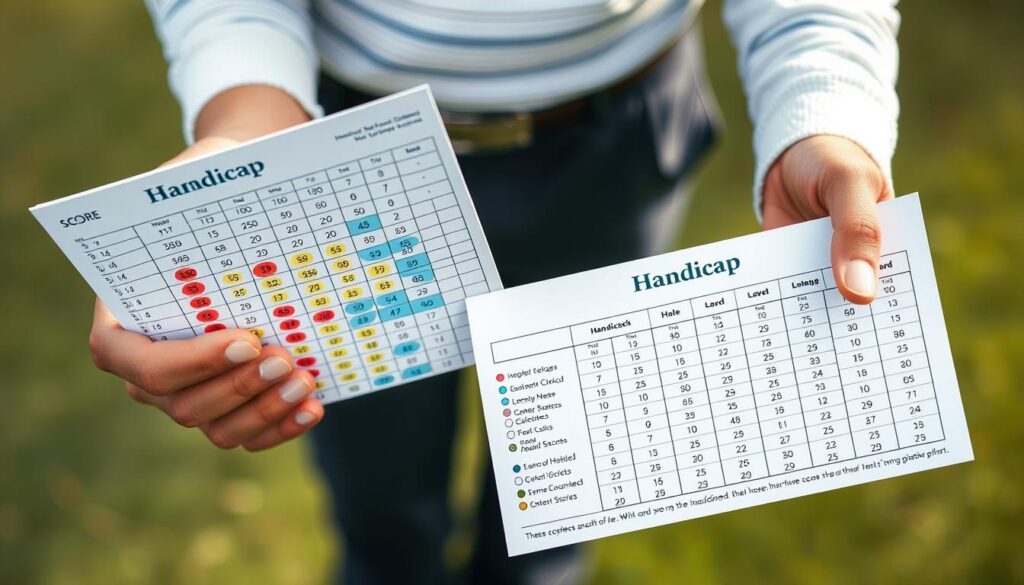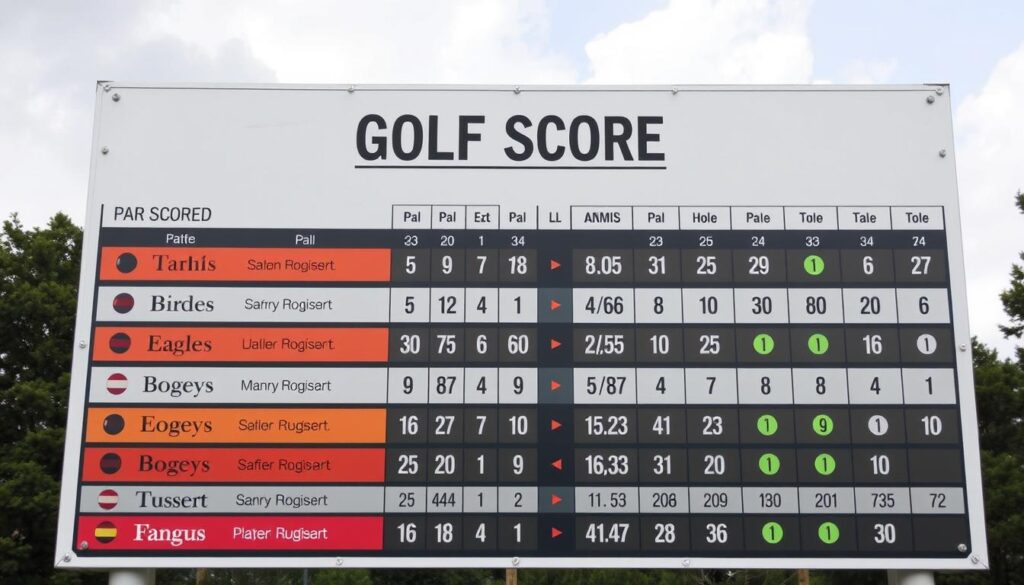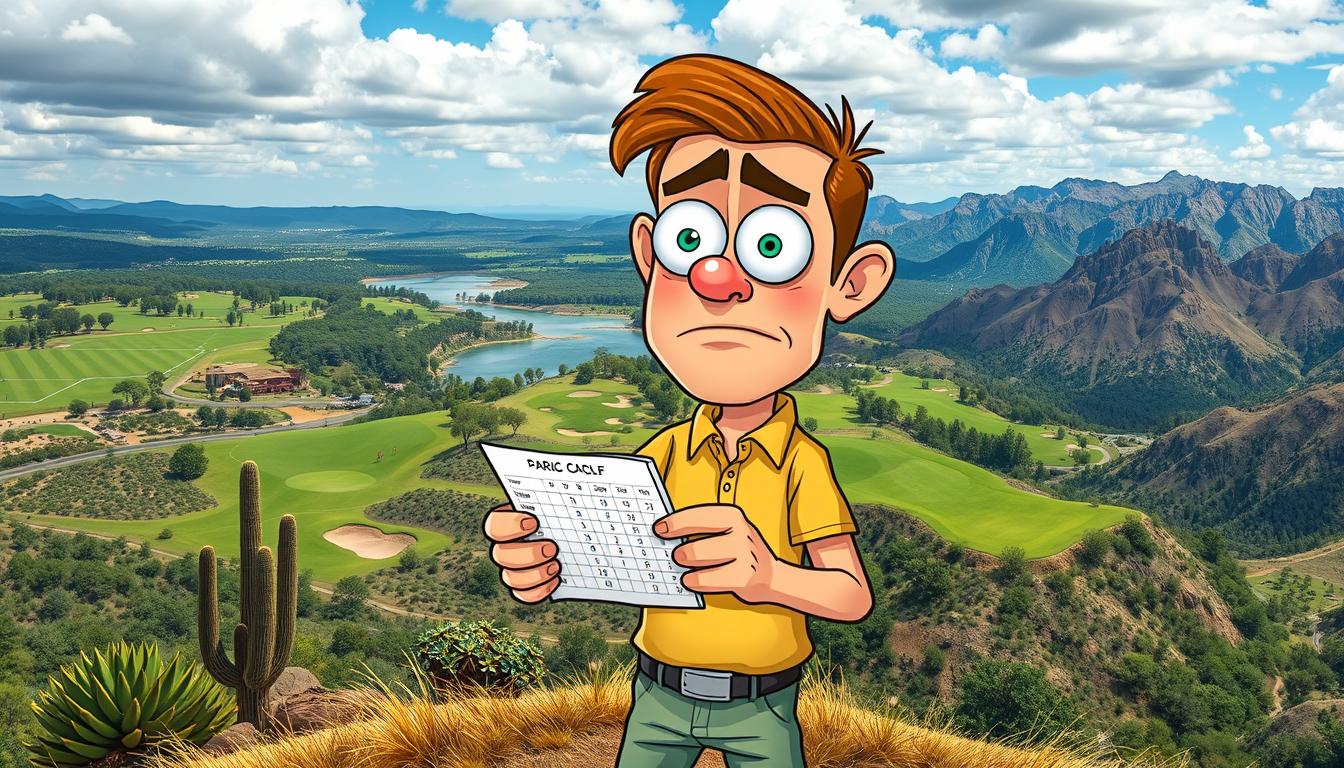Did you know that only 3% of golf courses worldwide have a par of 73 or higher? This fact underscores the diversity in golf course design and scoring. The concept of golf course par varies significantly across different courses. Next we will look at the intricacies of golf scoring and course design to grasp why each course is distinct.
Golf course par is a pivotal element that influences the game’s strategy and scoring framework. Many believe all courses have a uniform par, but this is far from true. Designers take into account the terrain, obstacles, and hole lengths to set the par for each hole. This approach to golf course difficulty enhances the game’s excitement and challenge.
The typical par for an 18-hole course is between 70 and 72. This figure is a blend of par-3, par-4, and par-5 holes. The United States Golf Association (USGA) defines par as the score an expert player should achieve, assuming two putts per green. This standard underpins course design and scoring systems globally.
Key Takeaways
- Golf course par varies based on design and difficulty
- Standard 18-hole course par typically ranges from 70 to 72
- Par is determined by hole length and expert player capabilities
- Course designers consider terrain, obstacles, and playing strategy
- Understanding par is crucial for effective golf scoring and strategy
Table of Contents
- 1 Understanding Par in Golf
- 2 Variations in Par Across Golf Courses
- 3 Standard Par for Golf Courses
- 4 Famous Golf Courses with Unique Par Configurations
- 5 How Par Affects Gameplay and Strategy
- 6 Adjusting Par for Different Skill Levels
- 7 The Role of Par in Golf Tournaments
- 8 Designing a Golf Course: The Role of Par
Understanding Par in Golf

Par is the number of strokes an expert golfer should take to finish a hole or the entire course. Grasping par is critical to evaluating your performance and enhancing your game.
What Par Means in Golf
Simply put, par is the standard score for each hole. Most 18-hole courses have a total par of 72. Your score is compared to par, with positive numbers indicating you’ve taken more strokes and negative numbers showing you’ve taken fewer strokes.
Significance of Par
Par is vital for assessing your skills and tracking progress. It’s also crucial in determining the difficulty of each hole and setting course ratings. Green fees often reflect a course’s par and the level of challenge it offers.
Determining Par for Individual Holes
The primary factor in setting par is the hole’s length. The USGA provides guidelines for men:
- Par 3: Up to 250 yards
- Par 4: 251 to 470 yards
- Par 5: 401 to 690 yards
Women’s yardages are slightly shorter. Course designers use these ranges to plan the layout.
Typical Par Values
Most holes fall into three categories:
| Hole Type | Par Value | Men’s Yardage | Women’s Yardage |
|---|---|---|---|
| Par 3 | 3 | Up to 260 yards | Up to 220 yards |
| Par 4 | 4 | 240-490 yards | 200-420 yards |
| Par 5 | 5 | 450-710 yards | 370-600 yards |
Par 6 holes are rare but exist. They’re over 670 yards for men and 570 yards for women. Understanding these values aids in planning your strategy and selecting the right equipment for each hole.
Scoring par is a significant challenge. For beginners, averaging a bogey (one over par) on each hole is a commendable feat.
Variations in Par Across Golf Courses

The par of a course can differ significantly between golf courses, influenced by various factors. These factors make each golfing experience unique. Let’s look at what affects par variations and examine some unusual examples.
Factors Influencing Course Par
The par of a golf course is not fixed. It’s determined by several elements, including:
- Terrain: Hilly courses may have shorter holes, affecting par.
- Obstacles: Water hazards and bunkers can increase difficulty, impacting par.
- Design philosophy: Architects may create unique challenges through par configuration.
- Land constraints: Available space can limit hole lengths and par options.
Examples of Unusual Par Values
Some courses have par configurations that deviate from the norm. You might find:
- Consecutive par-3 holes for added short game challenge
- Multiple par-5 holes to test your long game
- Par-70 courses, often considered more challenging
- Rare par-6 or even par-7 holes on some courses
These par variations make unique golf courses stand out. When booking tee times, consider these differences for a fresh golfing experience.
| Course | Green Fees | Tee Time Rates | Booking Window |
|---|---|---|---|
| Pine Valley Golf Club | $350 | $150 – $250 | 7 days |
| Merion Golf Club | $300 | $125 – $225 | 14 days |
| Oakmont Country Club | $325 | $140 – $240 | 10 days |
Course layout and par variations significantly impact your game strategy. Whether you’re playing a standard par-72 or a unique par-70, adapting to the course’s design is crucial for improving your score.
Standard Par for Golf Courses

Most 18-hole layouts share a common par range. Typically, the total par for a course lies between 68 and 72. This figure aggregates the par of each hole across the entire layout.
Overview of Standard Par Values
Traditional courses often feature ten par 4s, four par 5s, and four par 3s, adding up to a par of 72. This layout balances challenge with playability. Temperature and other environmental factors can alter how holes play, affecting strategy and shot selection.
Professional vs. Amateur Courses
Professional golf courses usually have higher pars due to their length and difficulty. Conversely, amateur courses often have shorter holes and lower pars. This variance caters to the differing skill levels of professionals and amateurs.
Impact of Course Difficulty on Par
Course difficulty is crucial in determining par. Elements like uphill slopes, strong winds, and hazards can affect a hole’s rating. For example, a 450-yard hole might be rated as a par 5, not a par 4, due to its exceptional challenges.
| Golf Course | Greens Fees | Tee Times |
|---|---|---|
| Augusta National | $525 (member guest) | By invitation only |
| Pebble Beach | $575 | 7:00 AM – 5:00 PM |
| St. Andrews Old Course | £270 (peak season) | 6:30 AM – 6:00 PM |
Famous Golf Courses with Unique Par Configurations
![]()
Golf enthusiasts dream of playing on iconic courses that challenge and captivate. Let’s look at some championship courses, celebrated for their distinctive par setups and stunning vistas.
Augusta National Golf Club
Augusta National, the venue of the Masters Tournament, is a par-72 course that pushes even the top players to their limits. Its Amen Corner, comprising holes 11, 12, and 13, is infamous for its formidable difficulty and aesthetic allure. The course’s immaculate conditions and fairways lined with azaleas create a golfer’s utopia.
St. Andrews Links
The Old Course at St. Andrews, dubbed the “Home of Golf,” is a par-72 layout steeped in history. Its distinctive double greens and the iconic Swilcan Bridge offer an experience that lingers in memory. The course’s natural layout and deep pot bunkers have tested golfers for generations.
Pebble Beach Golf Links
Pebble Beach, a par-72 course, is famous for its awe-inspiring coastal scenery. The renowned 7th hole, a short par-3 perched on a cliff, presents one of golf’s most spectacular tee shots. The 18th hole, hugging the Pacific Ocean, offers a dramatic conclusion to your game.
These elite courses demonstrate how par can be seamlessly integrated into top-tier designs. For those aiming to play these prestigious venues, here’s a breakdown of greens fees and booking details:
| Course | Greens Fees | Tee Time Booking |
|---|---|---|
| Augusta National | Member-only access | Not available to public |
| St. Andrews Old Course | £270 (peak season) | Ballot system or authorized providers |
| Pebble Beach | $595 (plus cart fee) | Online or phone reservation |
Playing these iconic courses is more than a game of golf. It’s a chance to tread in the footsteps of legends and encounter the unique challenges that have molded the game’s history.
How Par Affects Gameplay and Strategy

Par is an important element in shaping golf strategy and course management. It helps players make strategic decisions and overcome challenges. Let’s look at how par impacts gameplay and the psychological aspects of golf.
Impact on Player Strategy
Par influences golfers’ decision-making. On par-5 holes, aiming for the green in two shots for an eagle is a common goal. Par-3s require precise tee shots. Knowing the par for each hole aids in planning and risk management.
Adjusting Play Based on Par
Golfers tailor their play to par. Aiming to break par often requires hitting 10-13 Greens in Regulation (GIR). Limiting bad tee shots to 2-3 out of 14 drives is also key. These statistics underscore the need for consistent performance across par levels.
Psychological Aspects of Playing to Par
The mental aspect of golf is equally crucial to the physical. Par acts as a psychological benchmark. Aiming to meet or beat par can intensify pressure, especially in competitive play. Adopting a consistent shot pattern, like a draw or fade, can reduce misses and alleviate pressure.
| Par Type | Strategy Focus | Psychological Challenge |
|---|---|---|
| Par 3 | Precision tee shots | Pressure for one-shot accuracy |
| Par 4 | Balanced approach | Consistency across two shots |
| Par 5 | Risk vs. reward decisions | Temptation for aggressive play |
Elements like 3-meter putting, basic chipping, and 10-meter bunker shots significantly affect your score. Grasping how par influences gameplay enables you to craft effective strategies for better performance on the course.
Adjusting Par for Different Skill Levels

Golf courses offer various tee options to accommodate players of all abilities. These different tees adjust the par and challenge level, making the game enjoyable for everyone. Next we will look at how courses cater to diverse skill levels and age groups.
Tee Options and Par Adjustments
Golf courses typically feature multiple tee boxes, each designed for specific skill levels. Forward tees shorten holes, making them more manageable for beginners, juniors, and seniors. Back tees challenge advanced players with longer distances. This setup allows courses to maintain different pars for the same hole, depending on the tee used.
Understanding Golf Handicap
Your golf handicap relates closely to par. It represents the number of strokes above par you’re expected to score on an average round. For example, if you have a 15 handicap, you’d typically shoot about 15 strokes over par on a standard course. This system lets players of varying abilities compete fairly against each other.
Junior and Senior Golf Considerations
Junior golf and senior golf programs often use forward tees with adjusted pars. These modifications make the game more accessible and fun for younger players still developing their skills and older golfers who may not hit the ball as far. Some courses even offer special membership details for these age groups, encouraging participation and enjoyment of the sport.
Remember, when starting out, it’s wise to begin with used golf clubs. This approach helps you explore different club types without breaking the bank.
| Player Type | Recommended Course Length | Ideal Slope Rating |
|---|---|---|
| Male Beginners | Up to 6,000 yards | 120 or less |
| Female Beginners | Around 5,000 yards | 120 or less |
| Advanced Players | 6,000+ yards | 130+ |
The Role of Par in Golf Tournaments

Par is essential in golf tournaments, influencing scoring systems and player strategies. In professional golf, par acts as the standard for evaluating performance. Scores are reported relative to this par, making it a critical element.
Scoring and Ranking Players
Golf tournaments rely on par for their scoring system. Players’ results are often noted as over, under, or at par. This method simplifies comparisons across various courses and tournaments. The USGA introduced par in 1911, transforming golf scoring and play.
Unique Par Challenges in Tournaments
Some tournaments feature courses with unique par configurations, challenging players’ skills. Courses might have an unusual number of par 3s or long par 5s, influencing how elevation affects ball distance and strategy. These variations significantly impact scoring and add excitement to the competition.
Par in Major Championships
In major golf championships, par’s importance is amplified. Course setups are often adjusted, sometimes changing par for specific holes to increase difficulty.
| Tournament | Course Par | Notable Features |
|---|---|---|
| The Masters | 72 | Amen Corner (holes 11-13) |
| U.S. Open | 70-72 | Often features narrow fairways and thick rough |
| The Open Championship | 70-72 | Links-style courses with unpredictable weather |
| PGA Championship | 70-72 | Rotates between challenging courses |
Understanding par’s role in golf tournaments deepens your appreciation for the game’s scoring complexities and the challenges players face on championship courses.
Designing a Golf Course: The Role of Par
Golf course architecture is a blend of art and science. Architects must balance many factors, with par being key to the layout and playability. Typically, an 18-hole course aims for a par of 72, with a mix of par 3, 4, and 5 holes.
Balancing Challenge and Playability
Designing a course is more than just setting pars. Architects aim to make the game challenging yet enjoyable for all skill levels. Courses can vary in length, from 5,000 to 7,400 yards, to suit different abilities and weather conditions. This flexibility allows for unique features that challenge even top players.
Innovations in Course Design
Modern golf course architecture is redefining traditional norms. Tom Doak’s Pacific Dunes features an unconventional layout with varied par combinations. Similarly, Coore & Crenshaw’s Cabot Cliffs has six par 3s, 4s, and 5s, adapting to the terrain while maintaining a par of 72. These examples show how architects prioritize the land’s natural features, creating visually stunning and challenging courses.
Understanding these design principles can deepen your appreciation for golf courses. And for improving your game, using a golf rangefinder can enhance accuracy and lower your handicap, making you better at navigating these well-designed courses.






